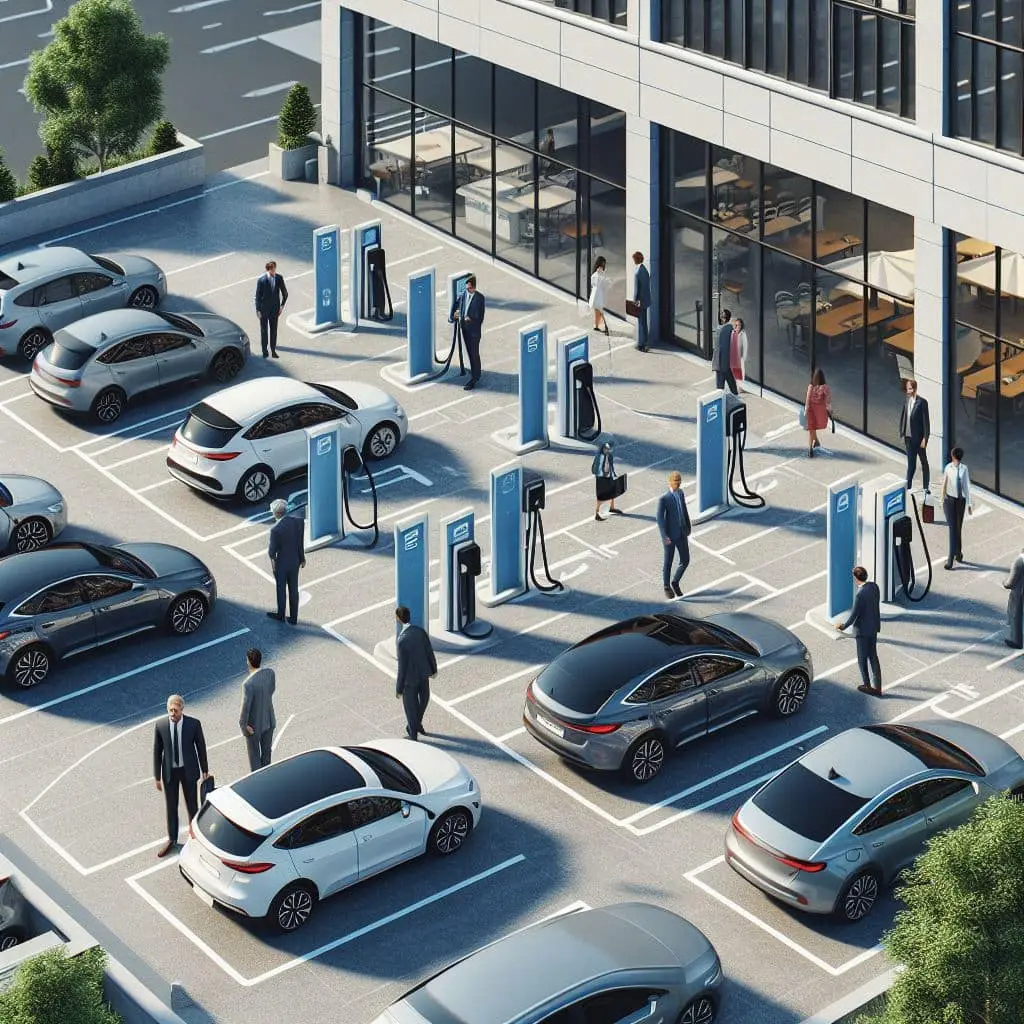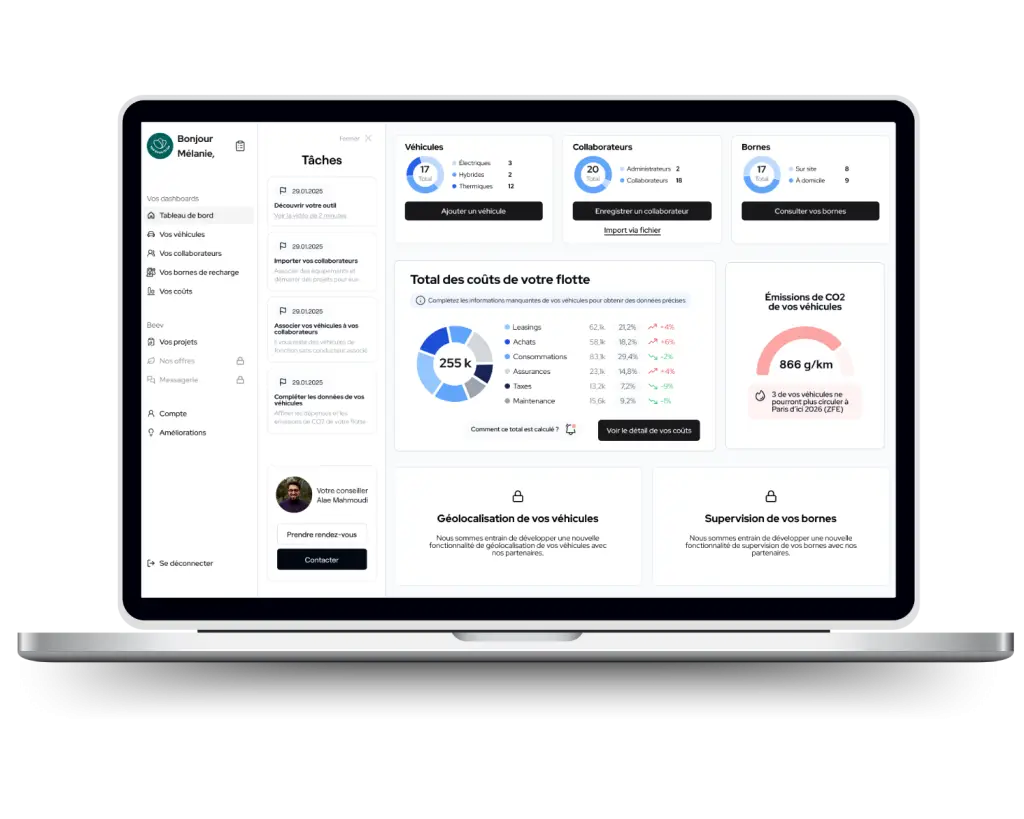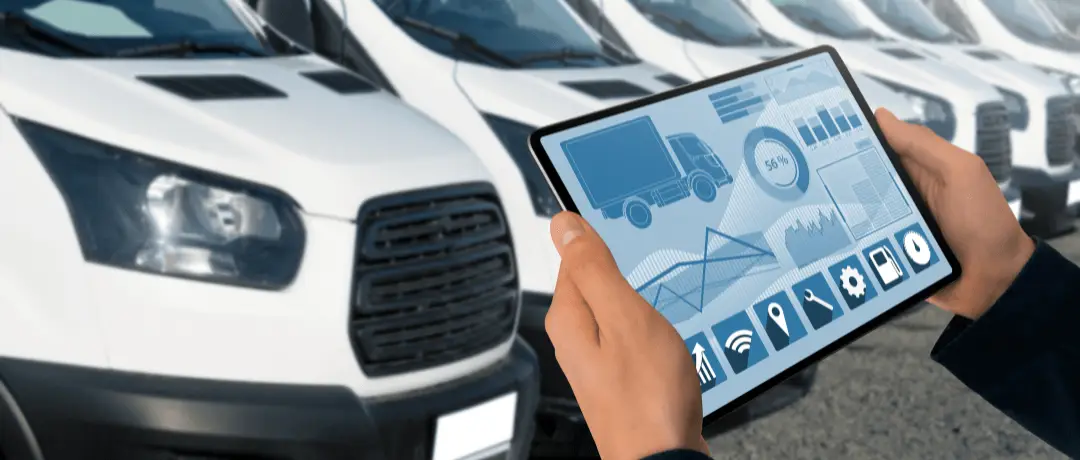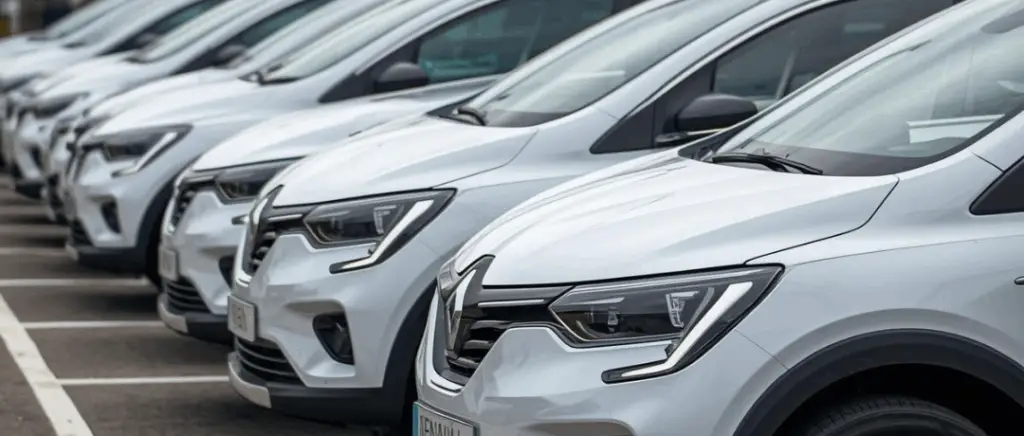Understanding fleet management: much more than just tracking vehicles
Why has fleet management become a key issue for general and financial management?
Today, the management vehicle fleet is no longer confined to the simple administration of vehicles: it has become an essential strategic lever for general and financial management. Faced with rising operating costs, increasingly complex regulations and the need for more responsible mobility, it is essential to have effective tools at your disposal to manage your fleet efficiently. Optimised management not only makes it possible to achieve substantial savings on major items of expenditure (fuel, maintenance, insurance), it also enhances employee safety and meets new expectations in terms of energy transition.
Investing in a modern fleet management solution gives your business the ability to analyse usage data in real time, anticipate maintenance needs, reduce CO₂ emissions and ensure compliance with the latest standards. By entrusting the management of your fleet to an expert or adopting an innovative digital platform, you transform a cost item into a genuine performance and image driver for your organisation.
Who are the players involved in the value chain (fleet manager, CFO, HR, purchasing, IT, etc.)?
- Fleet manager
A true orchestra conductor, he or she centralises and coordinates all operations relating to the vehicle fleet. With expert support in the energy transition, they can anticipate electrification needs and ensure proactive, efficient fleet management. - Administrative and Financial Department (DAF)
As the guardian of profitability, the CFO ensures that costs are kept under control and that investments are in line with requirements. Thanks to a specialised audit, it becomes easier to identify savings levers, benefit from tax incentives and secure investments in the transition to electric vehicles. - Human Resources (HR)
HR plays a key role in driver safety and well-being. Supporting training in eco-driving and the integration of electric vehicles contributes to employee satisfaction and to the company's CSR policy. - Purchasing department
Responsible for negotiating and dealing with suppliers, the purchasing department maximises the value of contracts. By drawing on specialist expertise, it is possible to select the best electric vehicles and install appropriate charging stations, while keeping the total cost of ownership under control. - IT Department
IT ensures the integration and security of the company's digital solutions. fleet management. Connected tools can be used to centralise data, automate monitoring and facilitate collaboration between departments, making fleet management smoother and more efficient. - External service providers (rental companies, insurers, maintenance companies, etc.)
These partners provide expertise and flexibility. Long-term leasing and recharging solutions compatible with a wide network of charging points simplify the transition to a greener fleet and reduce the administrative burden for businesses.
As a recognised expert in the transition of fleets to electric vehicles, Beev adds value to every stage of your project: from the initial audit to the final decision.installation of charging stationsThis expertise transforms the complexity of electrification into a strategic, sustainable and competitive opportunity for your company. This expertise transforms the complexity of electrification into a strategic, sustainable and competitive opportunity for your company.
What levers can you activate to make your fleet more efficient, more sustainable and strategically controlled?
How can you calculate and reduce the total cost of ownership (TCO) of a vehicle in your fleet?
Calculating the cost total cost of ownership (TCO) of a vehicle is based on the sum of all the direct costs (purchase or hire, fuel, insurance, maintenance, taxes, etc.) and indirect costs (depreciation, administrative management, environmental costs, etc.) over a given period, generally 3 to 5 years. To get an accurate picture, you need to integrate all these elements and compare the overall cost per kilometre travelled. By using specialised management tools and regular audits, you can identify the biggest items of expenditure and optimise each stage, from vehicle selection to resale.
For reduce TCO, Choose vehicles that are suited to your needs, plan ahead for maintenance, negotiate your insurance and finance contractsTake advantage of electric or hybrid mobility solutions to benefit from tax advantages and reduced running costs.
What are the hidden costs of your fleet... and how can you eliminate them?
In addition to the obvious costs, fleet management involves many hidden costs: accelerated depreciation of vehicles, administrative costs associated with contract management, penalties for exceeding mileage, costs associated with regulatory non-compliance, and environmental impact (taxes), ecologic malusetc.).
These costs, which are often underestimated, can weigh heavily on overall profitability. To eliminate them, it is essential to adopt a proactive management approach: digitalise administrative monitoring, implement reporting tools to anticipate overruns, train your teams in eco-driving and preventive maintenance, and give preference to vehicles with a low environmental impact. By regularly analysing fleet data and working with industry experts, you can quickly identify and correct these sources of extra cost.
Why regular servicing saves you time and money?
Regular servicing of your vehicles is the key to keeping your fleet management efficient and economical. Structured preventive maintenance can reduce repair costs by 30 to 40 %, extend the life of vehicles and optimise their resale value.
By anticipating service calls with a personalised schedule and the use of digital tools, you can reduce the risk of unexpected breakdowns, avoid costly downtime and guarantee the operational availability of your fleet. By training your drivers to detect faults early and working with maintenance professionals, you can ensure a more reliable fleet, while keeping your costs under control over the long term.
Financing, leasing, taxation: how can you optimise your fleet budget management?
Leasing, long-term hire, LOA: which financing options are right for your strategy?
| Actor concerned | Long-term leasing | LOA (Lease with Purchase Option) | Leasing (generic) / Crédit-bail |
|---|---|---|---|
| Fleet manager | Simplified management with services included (maintenance, assistance, insurance). Ideal for regularly renewing your fleet and avoiding the hassle of resale. | Allows you to test drive a vehicle before buying. More complex to manage if purchase option exercised (resale, depreciation). | Offers the possibility of adapting the fleet according to needs, but requires rigorous administrative follow-up |
| Finance Department (DAF) | Fixed rents, deductible operating costs, no fixed assets on the balance sheet. Budget control and tax optimisation. | Lease payments deductible until the vehicle is purchased. If purchased, impact on balance sheet (fixed assets, depreciation) | May involve an initial contribution and depreciation management if purchase option exercised |
| Purchasing department | Easy negotiation thanks to the all-inclusive offer. Access to recent vehicles without raising capital. Flexibility in the choice of models | Possibility of negotiating the buy-back value at the end of the contract. Freedom to become the owner or to return the vehicle. | Freedom to choose the term, model and conditions of redemption. |
| Human Resources (HR) | Recent, reliable and safe vehicles for employees. Services included to limit constraints for drivers | Some employees can be offered the chance to purchase the vehicle at the end of their contract. More individual flexibility | Suitable for specific or seasonal needs, but requires personalised management |
| IT Department | Connected solutions often included, simplifying fleet data management and integration with in-house tools | Can be integrated with management tools, but specific monitoring when the vehicle is purchased | Management of digital tools to be adapted according to the type of contract and its duration |
For each player, the LLD stands out for its simplicity and budget control, ideal for optimised fleet management with no surprises. The LOA offers greater flexibility for testing or acquiring a vehicle, suited to those who want to build up their assets. Generic leasing allows the financing strategy to be adapted to the changing needs of the business.
Expert support for structuring your fleet will enable you to choose the most appropriate solution for your objectives and strategy.
Read our article about :
What are the tax and accounting implications of structuring your fleet?
From a tax and accounting point of view, the financing method you choose has a direct impact on your company's financial structure. With the LLDThe lease payments are booked as operating expenses, which reduces taxable income and optimises the company's tax position. The vehicles do not appear on the assets side of the balance sheet, which preserves the company's debt capacity and financial strength.
Visit LOAHowever, if the company decides to purchase the vehicle at the end of the contract, it is recorded as an asset on the balance sheet and depreciated over its remaining useful life. This can have an impact on financial ratios and the presentation of accounts.
Lastly, controlling the tax and accounting impact also means complying with the ceilings on the deductibility of rents, and ensuring that the following factors are taken into account company vehicle tax management and taking into account any incentives for thefleet electrification. Specialised support is available to optimise the structuring of your fleet while maximising tax benefits and simplifying accounting management.
Electrification, flexible mobility, new technologies: how can we prepare the fleet of tomorrow?
Vehicle charging points, taxation, skills development: are you ready to electrify your fleet?
- Preliminary audit Assess the number of vehicles to be electrified, charging requirements, the electrical power available on site and the compatibility of existing infrastructure in order to anticipate needs and optimise deployment.
- Choice of equipment Choose charging stations that are adapted to your needs, generally from 7.4 to 22 kW, or even fast charging stations if necessary. The regulatory minimum power may vary depending on the configuration, but the key is to ensure that the solution you choose is scalable and appropriate.
- Certified installer : Call on an IRVE professional (Recharging Infrastructure for Electric Vehicles) to guarantee the compliance, safety and durability of your installation. This qualification is compulsory for all charging points above 3.7 kW.
- Financial aid Charging infrastructure: Find out about local or sectoral subsidies that can reduce the initial investment in charging infrastructure. National and regional programmes exist to support companies in this transition.
- Taxation Take advantage of the tax benefits associated with electrification, such as exemption from VAT, accelerated depreciation of electric vehicles and the possibility of reclaiming VAT on recharging.
- In-house skills : Train your teams in electric driving and the management of new supervision tools to ensure a smooth, efficient and sustainable transition to electric mobility.
Read our article about :
Fleet-as-a-Service (FaaS): should we move from an owned fleet to shared, flexible mobility?
Moving from an owned fleet to a Fleet-as-a-Service (FaaS) solution offers numerous advantages in terms of flexibility, management and cost control. The FaaS model, based on cloud and SaaS solutions, gives businesses access to shared, scalable mobility, without the constraints of traditional fleet ownership or management. With a subscription or pay-as-you-go model, you benefit from centralised management, real-time access to all fleet data, and included services such as servicing, maintenance and assistance.
This model facilitates rapid adjustment of the size of the fleet according to activity, limits capital expenditure, and ensures that the fleet is always up-to-date and adapted to requirements. The FaaS solution also includes digital tools that can be accessed from any connected device, offering total visibility and greater responsiveness for fleet managers and mobile employees. Costs are smoothed via a monthly subscription, maintenance and updates are handled by the service provider, and data security is enhanced by hosting on external servers.
By adopting shared, flexible mobility via FaaS, you gain greater agility, optimise your fleet management, reduce the risks associated with ownership, and focus on your core business while responding to the new uses and challenges of professional mobility.
Case studies and best practice: which companies are successfully transforming their fleets?
Case study: how an SME halved its fuel costs in 18 months
A medium-sized company has succeeded in halving its fuel costs in 18 months by adopting a two-pronged strategy: the gradual integration of electric vehicles into its fleet and the reduction of its fuel consumption.optimised route management. By replacing 40 % combustion vehicles with electric models and training its teams in eco-driving, the company saw an immediate drop in fuel consumption.
By For example, for a fleet of 100 vehicles travelling an average of 25,000 km/year, annual fuel costs (at €1.80/L and 6 L/100 km) amounted to €270,000..
After partial electrification and optimisation, the annual bill fell to €135,000, a saving of €135,000 over 18 months. The company has also taken advantage of government discounts on fuel and subsidies for the purchase of electric vehicles to accelerate its transition.
Example of a multi-site group that has centralised its fleet management using a unified platform

A logistics group operating at 12 sites and with 320 vehicles has centralised the management of its fleet using a unified digital platform. Before this transformation, each site used its own tools, which led to errors, duplication and a considerable loss of time. With the introduction of multi-company management software, each entity retains its own autonomy while benefiting from a consolidated global view. Centralised dashboards allow you to monitor the status of the fleet, maintenance, consumption and costs in real time.
As a result, the Group has cut administrative costs by 20 %, improved coordination between sites and improved responsiveness when it comes to vehicle maintenance and renewal.
How a construction company improved the safety of its teams using real-time geolocation
In the construction and public works sector, geolocation of vehicles and machinery has become an essential safety and optimisation tool. One company in the sector has equipped its entire fleet with a geolocation system that tracks movements in real time, warns of risky behaviour (sudden braking, speeding), and immediately locates machinery in the event of theft. This system has led to a significant reduction in on-site incidents, better management of working hours and optimisation of journeys.
Management has seen a 30 % reduction in accidents and lower costs associated with maintenance and equipment losses, while boosting the confidence and safety of its teams in the field.
Managing a fleet management project: stages, pitfalls to avoid and key success factors
Where should you start? Audit, strategic framework and needs analysis
The first step in an effective fleet management project is to carry out a full audit of the existing fleet. This 360° audit provides a clear picture of costs, vehicle use, safety, regulatory compliance and environmental impact. On this basis, it is possible to frame the strategy to be adopted, by aligning the fleet objectives with those of the company (cost reduction, energy transition, safety, etc.).
Needs must be analysed in depth: what types of vehicle are required, what are the priority uses, what are the expectations of users and what are the regulatory constraints? This structured approach avoids inappropriate investments and enables you to build a coherent, high-performance fleet policy.
What criteria should you take into account when choosing a service provider or software package suited to the size of your business?
The choice of a service provider or a fleet management software must be based on several essential criteria. It is essential to select a scalable solution, capable of adapting to the size and diversity of your fleet, whether it consists of a few vehicles or several hundred. Key functionalities to focus on include data centralisation, cost tracking (TCO), preventive maintenance, geolocation, integration with other systems (accounting, HR), and ease of use for teams.
As such, Beev stands out for its comprehensive and intuitive platform, suitable for both small and large businesses. The Beev tool allows you to manage your entire fleet free of charge, track your costs in real time, monitor CO₂ emissions, optimise the management of charging stations and precisely analyse TCO to make informed decisions in line with your CSR objectives.
Beev also offers personalised support for the acquisition of electric vehicles or the installation of recharging infrastructure, while providing centralised management of documents and drivers. Finally, it is advisable to compare offers taking into account budget, contract flexibility and the ability of the software to evolve with the company's needs - criteria on which Beev provides real added value thanks to its scalable solution at no extra cost.
Comparative table of fleet management tools: Beev vs. other market solutions
| Criteria | Beev Fleet Manager | Other solutions on the market |
|---|---|---|
| Cost of access | 100% free, with no hidden charges | Pay-as-you-go, generally by monthly or annual subscription, with additional costs for certain options |
| Fleet management | Centralised management of vehicles, drivers and charging points, suitable for companies of all sizes | Centralised management, often suitable for large fleets, sometimes less intuitive for smaller organisations |
| Energy transition | Personalised support for electrification, monitoring of CO₂ emissions, calculation of TCO for EVs | Variable support for electric vehicles, often designed for combustion or mixed fleets |
| Main features | Real-time monitoring, events calendar, document centralisation, customised reports, cost and TCO optimisation | GPS tracking, expense management, maintenance, customisable alerts, advanced reporting depending on solution |
| Ease of use | Intuitive platform, SaaS access from computer or mobile, rapid installation | Interfaces can be complex, requiring training or further integration |
| Support | Expert support for the acquisition of EVs, the installation of charging points, document management and the energy transition | Support varies between publishers, often limited to technical support |
| Adaptability | Suitable for VSEs, SMEs, ETIs and large groups, scalable at no extra cost | Often modular solutions, mainly for medium-sized and large companies |
Beev Fleet Manager is free, easy to use and dedicated to supporting the energy transition, while offering advanced management and monitoring functions.TCO optimisation for all types of fleet.
Other solutions on the market offer powerful, modular tools, but generally involve higher access costs, greater integration complexity and less specialisation in fleet electrification.
Read our article about :
Conclusion
The transition to an electric fleet is now a key driver of performance, savings and environmental commitment for any company. By mastering every stage, from the choice of cars and electric vanstheinstallation of recharging points for professionalsincluding professional leasing offers and the integration of solutions such as photovoltaic panelsyou optimise your costs while reducing your environmental footprint. carbon footprint. With Beev, you'll benefit from comprehensive support, recognised expertise and tailor-made solutions to ensure your transformation goes smoothly.
Don't wait any longer to structure your project and make your company a committed player in sustainable mobility: Beev is the ideal partner to speed up and simplify your transition to electric vehicles.




































